Physical Address
304 North Cardinal St.
Dorchester Center, MA 02124
Scrotal sonography was first introduced in the mid-1970s. It remains the imaging modality of choice because it is simple, relatively inexpensive, and quick. Continuing refinements in imaging technology with higher-frequency transducers, and increased Doppler sensitivity have greatly enhanced perception of testicular anatomy and pathology. The haemodynamic information acquired with Doppler adds to the imaging findings; frequently reinforcing and often clinching the diagnosis. In this era, a thorough ultrasound evaluation of the scrotum must include Doppler.
The two clinical conditions that most commonly warrant an ultrasound examination with Doppler are evaluation of acute scrotal pain and a palpable scrotal mass. Differentiating an acute inflammatory process from testicular torsion is now the domain of colour Doppler. Differentiating a mass as intratesticular versus extratesticular can be accomplished by imaging alone, but colour Doppler adds valuable haemodynamic information and helps to further characterise the abnormality. Other common indications for use of scrotal Doppler include evaluation of trauma and infertility.
The normal adult testis is an egg-shaped gland which is approximately 3–5 cm in length and 2–4 cm in width and thickness with a volume of 4 cm 3 . Testicular size varies with age and stage of sexual development. The surface of the testicle is covered by the tunica albuginea, a thin, dense, inelastic fibrous capsule. Just within the tunica albuginea is the tunica vasculosa, through which the branches of the testicular artery course before entering into the gland ( Fig. 13-1 ). Numerous thin septations (septula) arise from the tunica albuginea and create 250–400 cone-shaped lobules containing the seminiferous tubules ( Fig. 13-2 ). These tortuous tubules course towards the mediastinum of the testis ( Fig. 13-3 ) and progressively merge to form larger ducts known as tubuli recti. These, in turn, join with each other to form a network of epithelium-lined spaces embedded in the fibrostroma of the mediastinum called the rete testis. These continue as 10–15 efferent ductules which pass into the head of the epididymis.
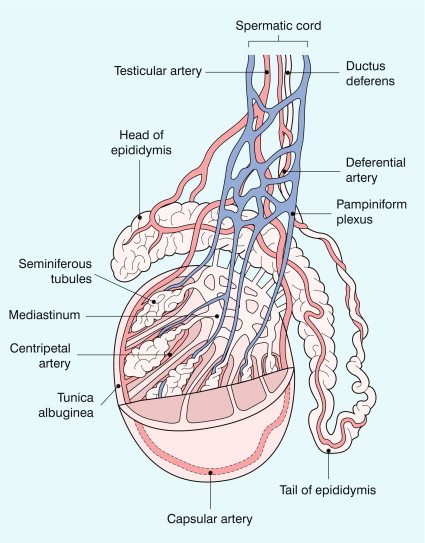
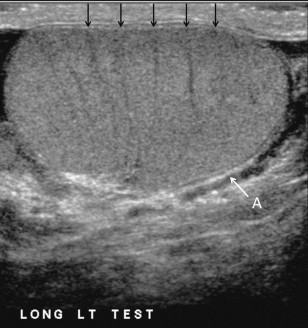
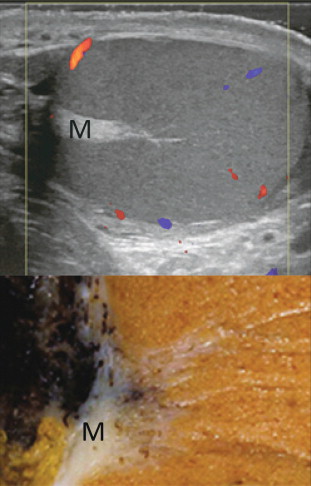
The epididymis is a comma-shaped structure that runs along the posterolateral aspect of the testis ( Fig. 13-4 ). The head of the epididymis is located next to the upper pole of the testis and receives the efferent ductules. The ductules eventually converge through the body and tail and form the vas deferens which continues on in the spermatic cord. Along with the vas, the cord also contains the testicular artery, cremasteric artery, differential artery, the pampiniform plexus of veins, the genitofemoral nerve and lymphatic channels.
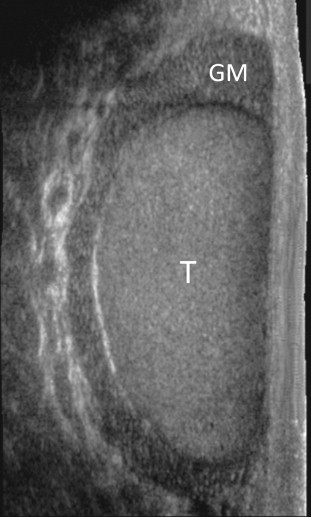
The testis and epididymis are enveloped by the tunica vaginalis, a fascial structure composed of an outer parietal layer and an inner visceral layer which surrounds the entire gland, except along the posterior aspect where the vessels and nerves enter. The extent to which the tunica vaginalis envelops the testis directly correlates with the risk for developing testicular torsion. The potential space between the parietal and visceral layers normally contains a small amount of lubricating fluid, but a larger volume of fluid in this space represents a hydrocele.
The right and left testicular arteries originate from the aorta just below the renal arteries. They course through the deep inguinal ring to enter the spermatic cord, accompanied by the cremasteric and deferential arteries, which supply the soft tissues of the scrotum, epididymis and vas deferens. The testicular artery penetrates the tunica albuginea along the posterior aspect of the testis and gives off capsular branches which course through the tunica vasculosa. These capsular branches then give rise to the centripetal arteries which carry blood from the capsular surface, centrally towards the mediastinum along the septula ( Figs 13-5 and 13-6 ). Branches of the centripetal arteries then course backward towards the capsular surface; these are known as recurrent rami. In about 50% of testes, a more robust artery can be seen passing directly from the testicular artery at the mediastinum into the parenchyma, known as the transtesticular artery ( Fig. 13-7 ). It is occasionally accompanied by a vein. Small anastomoses do exist between the testicular artery, cremasteric, and differential arteries. Branches of the pudendal artery may also supply the scrotal wall.
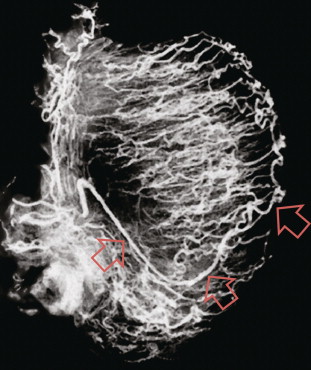
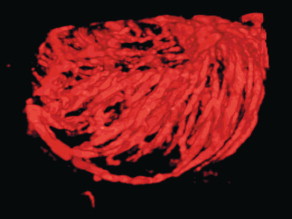
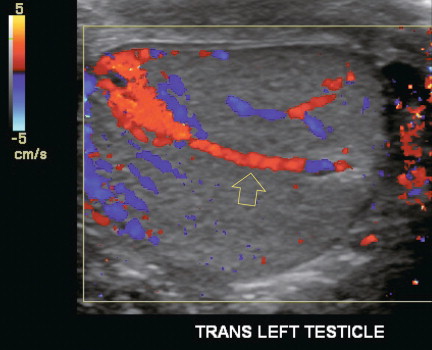
Testicular venous outflow courses mostly through the mediastinum testis, into the spermatic cord, and eventually up through the inguinal canal. As the veins exit the scrotum through the spermatic cord, they form a web-like network that surrounds the testicular artery, known as the pampiniform plexus ( Fig. 13-8 ). This plexus functions as a heat exchange mechanism, pulling warmth away from the testicular arterial inflow, thereby helping to maintain spermatogenesis at a lower, more optimal temperature.
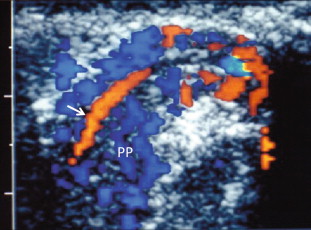
On the left side, the testicular vein usually drains into the left renal vein; on the right side, drainage is directly into the inferior vena cava just below the right renal vein. The testicular veins normally have valves that prevent retrograde flow of venous blood to the scrotum, but if they are absent or become incompetent; this predisposes to development of a varicocele. This results in compromise of the heat exchange mechanism and, therefore, is a frequent cause of infertility.
Prior to any ultrasound examination, the testes should be examined with a gloved hand, especially if the sonographic study is being conducted to evaluate a palpable mass. The examination is performed with the patient in the supine position. A towel is placed under the scrotum for support. If the testis is tender, the patient may be asked to hold it in a position which would facilitate the exam. This is particularly useful for the evaluation of a small mass. The patient should be asked to hold it between thumb and forefinger, and the ultrasound transducer is then gently placed upon it. Some men may have a vigorous cremasteric response during the examination resulting in the testis being drawn upward and puckering the scrotal wall. To avoid shadowing from trapped air, copious amounts of gel need to be worked into the scrotal skin folds. Imaging with the patient standing upright, or while performing a Valsalva manoeuvre, is useful for evaluating the testicular venous system, in particular for determining valvular competence in patients with suspect varicocele, or for improving detection of an inguinal hernia.
A high-frequency (10 MHz or greater) linear-array transducer is used for both greyscale and Doppler imaging, with direct contact scanning on the scrotal skin. Examination is performed in both the longitudinal and transverse planes for each testis to allow assessment of any differences in size and echogenicity between the two sides. The split screen mode is useful for side-to-side comparison. Oblique imaging of the epididymis and spermatic cord should also be performed. Any extratesticular masses or fluid collections should be noted as well.
Become a Clinical Tree membership for Full access and enjoy Unlimited articles
If you are a member. Log in here